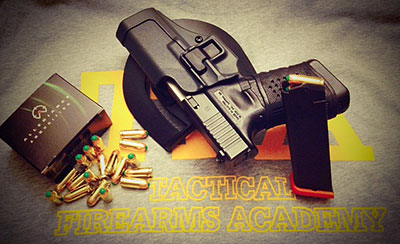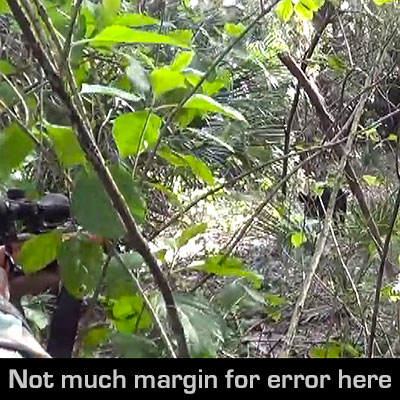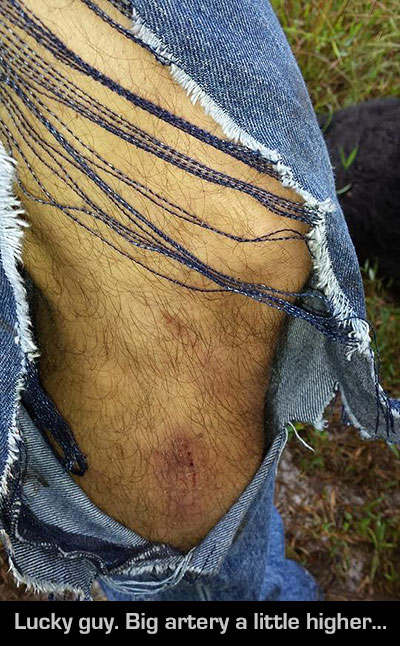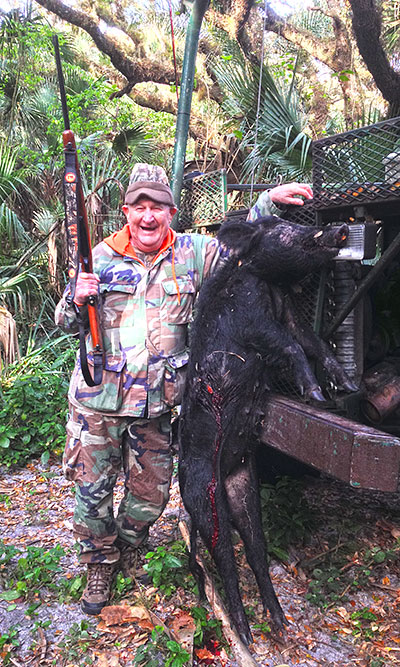
Close Quarters Hog Hunting is an exciting adrenaline filled experience, but there is always the remote chance it can be the scariest time in a hunter’s life. Funny how often those two elements show up together… Lots of dedicated hunters spend countless hours refining their marksmanship skills with their primary hunting rifle. But, what happens when one’s primary firearm malfunctions in that critical moment when a boar is charging? Many of these tactical failures have been captured on film and shared via social media. Unfortunately, many of these videos didn’t end well for the unarmed hunter who’s hands and feet provided little to no defense to the boar’s razor sharp cutters. What was the tactical failure? At a minimum, the absence of an accessible secondary firearm is one error, and a possible lack of training another. To illustrate this topic I’ve noted two real life scenarios below and added my personal suggestions including some helpful tactical training tips that you can do at home.
Several weeks ago, my father and I were part of a group hog hunt at Chappy’s Outfitters in Moore Haven, Florida. I shared my own personal hunt in last month’s SHWAT™ article, Close Quarters Hog Hunting (CQHH) “Ready”. My father’s hunt was a traditional buggy and hog dogs style hunt. Dogs haven’t been highlighted much here at SHWAT™, but if you think of them of something like the Force RECON of hog hunting (and bear hunting, and…), they fit right in. Bret Conway, the outfitter, has trained many of his dogs since they were puppies. It didn’t take long for one of the dogs to pick up a hog’s scent. I love the way the dogs change the tone of their bark once they’ve located and bayed up a hog.
 The buggy raced through the trails closer to the barking and squealing. Once we were close, my dad and Daniel, Bret’s trusted guide, jumped off the buggy and quickly moved into the dense saw palmettos and palms. I followed closely behind, weaving and ducking through the congested terrain. We followed the barking until we made visual contact. The two dogs had bayed up a mean wild boar directly in front of us, but due to the thick vegetation we couldn’t see it. My father was using a Ruger 30.06 rifle with a Vortex 4-12×40 optic as his primary firearm that day. He’ll be taking his shotgun next time… My dad did not carry a secondary firearm as we always hunt together when hunting with dogs. The hog came into view approximately 20 yards away for only a few seconds and then vanished. I spotted it again and we quickly set up for the shot. Again it vanished, so we moved closer. The boar then appeared out of nowhere, directly in from of us. It looked our way and started to charge our location. Daniel yelled, “SHOOT IT!…SHOOT IT!…SHOOT IT!”. Fortunately, the one shot my dad fired was a lethal blow and the hog dropped immediately. The hog was no more than 10 yards away and the Winchester 150 grain Power Point struck it down. We nervously laughed as we walked forward to view my dad’s kill. My dad quickly realized how potentially different and scarier this hunt could of ended.
The buggy raced through the trails closer to the barking and squealing. Once we were close, my dad and Daniel, Bret’s trusted guide, jumped off the buggy and quickly moved into the dense saw palmettos and palms. I followed closely behind, weaving and ducking through the congested terrain. We followed the barking until we made visual contact. The two dogs had bayed up a mean wild boar directly in front of us, but due to the thick vegetation we couldn’t see it. My father was using a Ruger 30.06 rifle with a Vortex 4-12×40 optic as his primary firearm that day. He’ll be taking his shotgun next time… My dad did not carry a secondary firearm as we always hunt together when hunting with dogs. The hog came into view approximately 20 yards away for only a few seconds and then vanished. I spotted it again and we quickly set up for the shot. Again it vanished, so we moved closer. The boar then appeared out of nowhere, directly in from of us. It looked our way and started to charge our location. Daniel yelled, “SHOOT IT!…SHOOT IT!…SHOOT IT!”. Fortunately, the one shot my dad fired was a lethal blow and the hog dropped immediately. The hog was no more than 10 yards away and the Winchester 150 grain Power Point struck it down. We nervously laughed as we walked forward to view my dad’s kill. My dad quickly realized how potentially different and scarier this hunt could of ended.
Little did any of our hunting party know that at the moment of engagement that my father had made a serious tactical error even before we jumped out of the buggy. After the celebration of a clean kill, he discovered that he had forgotten to load additional ammo into the rifle’s magazine. Thus, if that one shot had missed its mark and/or was ineffective, we would have had a wild boar at our feet within seconds. This is where the tactical advantage of a secondary firearm is so critical, unless perhaps we’re talking about hunting from a box blind.
My primary weapon, a 300BLK SBR was sitting in the buggy and the only defense I had was my Glock 9mm with 17 rounds of Allegiance Ammunition’s 95g PowerStrike ammo in the magazine. I feel confident that my tactical pistol training applied to 17 rounds of ammo against a would be adversarial wild hog would have eliminated his imminent threat. Hindsight is always 20-20 and the experience gives great purpose to educating my hunting buddies and the SHWAT™ hunting community on how to address the threat with one’s secondary firearm.
 My second story comes directly from Bret Conway of Chappy’s Outfitters. Last year a gentleman from Pennsylvania chose to hunt a hog with a knife. In Florida, knife and spear hunts are quite common when hog hunting with dogs. Apparently, the hog got loose from the dogs during the melee and charged the hunter. The hunter did have a secondary firearm, but it didn’t get deployed on time or at all. The specifics of the firearm and equipment were not disclosed. Fortunately, the damage was limited to badly cut jeans, bruises, an abrasion and his ego. The hunter was extremely lucky! In many cases, the sharp lower teeth create punctures and lacerations to the hunter necessitating immediate medical attention. Take a good look at any veteran hog dog and you’ll see plenty of scars from their close encounters with wild boar. Wild boar are extremely dangerous and they should never be underestimated.
My second story comes directly from Bret Conway of Chappy’s Outfitters. Last year a gentleman from Pennsylvania chose to hunt a hog with a knife. In Florida, knife and spear hunts are quite common when hog hunting with dogs. Apparently, the hog got loose from the dogs during the melee and charged the hunter. The hunter did have a secondary firearm, but it didn’t get deployed on time or at all. The specifics of the firearm and equipment were not disclosed. Fortunately, the damage was limited to badly cut jeans, bruises, an abrasion and his ego. The hunter was extremely lucky! In many cases, the sharp lower teeth create punctures and lacerations to the hunter necessitating immediate medical attention. Take a good look at any veteran hog dog and you’ll see plenty of scars from their close encounters with wild boar. Wild boar are extremely dangerous and they should never be underestimated.
The tactical component to this discussion focuses on the use of a sidearm as one’s secondary firearm. We’ll not get into the pros and cons of a revolver versus a pistol in this article. The focus is having a back up to the primary. The secondary firearm of choice should be something the hunter is familiar with and has shot frequently. I strongly suggest basic handgun training from an experienced and certified instructor. It’s imperative for this firearm to be at your waistband and holstered in a high quality retention holster. This is suggested to keep one’s muscle memory consistent with training.
 An additional tactical component is the actual transition from one’s primary weapon system to his secondary. The sidearm, ammo and the respective tactical holster are simply pieces of the puzzle. This tactical transition will assist hunters and shooters to learn an efficient way to get back into the hunt/fight in the event his primary malfunctions.
An additional tactical component is the actual transition from one’s primary weapon system to his secondary. The sidearm, ammo and the respective tactical holster are simply pieces of the puzzle. This tactical transition will assist hunters and shooters to learn an efficient way to get back into the hunt/fight in the event his primary malfunctions.
How is this tactical transition done? The transition can be done successfully with or without a sling (One or Two Point). With a sling, the shooter simply uses his weak hand to guide the rifle down and away from the body toward his weak side. At the same time, the shooter engages the secondary firearm. The steps are similar for non-sling transitions. The shooter in this case will grip the rifle’s forend/rail with his weak hand and bring it close to the chest, muzzle up but clear, while engaging the secondary with his strong hand. These transitions can easily be practiced at home with confirmed unloaded guns.
Hog hunting is such a great experience, but human error and firearm malfunctions are a reality. I hope my short stories, suggestions and training tips provided you additional insight. Safety first! Please share your best practices with your friends, family and hog hunting newbies. This will keep you and your hunting party much safer when out in the field.


